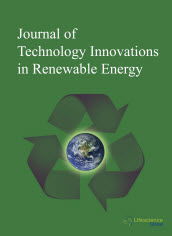jtire
|
|
|
Abstract: Using wind power generation is another alternative for remote homes, where there is no electricity grid. Especially in Ecuador there are several places where the wind resource is really stable for the year, though at times the wind regime it becomes turbulent wind speeds become quite high exceeding 12 m / s affecting the wind turbine components. Generally in the Ecuadorian highlands are available permanent winds of medium intensity capable of generating electricity, but by having a system of turbulence for short periods of time it jeopardizes the deployed equipment and therefore the investments made by what this study guarantees the stability of small wind turbines that are very useful in our environment to generate electricity in field type housing shelters. Keywords: Control, Wind Generators, Protection.Download Full Article |
|
|
|
Abstract: Reversible reaction couples of hydrogenation and dehydrogenation of organic compounds e.g. methylcyclohexane and toluene, or 2-propanol and acetone, are described in terms of hydrogen supplier to fuel cells, which will satisfy our demands of combined heat and power at various compact sizes. Carbon supported nano-sized metal particles, wetted with the liquid substrate in a reactor, was used for conversion of organic hydrides into hydrogen and organic compounds, being separable by distillation. Vigorous nucleate boiling is important for heat transfer as well as for irreversible bubble evolution, leading hydrogen to the vapor phase. Once the bubble is broken at the interface, catalytic hydrogenation will be prohibited, because gaseous hydrogen is unable to dissolve into the boiling liquid. Catalytic dehydrogenation under superheated liquid-film conditions can thus convert low-quality heats into hydrogen energy. Keywords: Dehydrogenation catalyst, Organic hydride, Superheated liquid-film.Download Full Article |
|
|
|
Abstract: While the Philippine Biofuels Act of 2006 mandates the use of anhydrous bioethanol as blend for gasoline, the potential of hydrous ethanol as an alternative fuel for spark-ignition engines has not been fully realized. This study explored the possibility of using hydrous ethanol as fuel for spark-ignition engines with minimal modifications and without the need for gasoline blend. A fuel feeding device was developed to feed hydrous ethanol fuel into the intake manifold of the engine, bypassing the carburetor. By replacing the components that are not compatible with hydrous ethanol and installing a fuel feeding device developed at PhilRice, two spark-ignition engines were able to run solely on 80-95% hydrous ethanol fuel. The fuel economy was found to be a significant issue in the utilization of hydrous ethanol fuel as there is a 75% increase in fuel consumption when using hydrous ethanol. There is potential for hydrous ethanol to be used as fuel if it can be produced locally and sold at half the pump price of gasoline. Keywords: Hydrous ethanol, fuel feeding device, spark ignition engine.Download Full Article |
|
|
|
Abstract: Organic solar cells (OSC)s are valuable economical and environmental friendly devices capable to generate electricity from sunlight. This is because of their simple fabrication process and minimal material usage in comparison to the inorganic solar cells. OSCs have not been widely commercialized yet because of their relatively low power conversion efficiency and stability problem. It is expected that these obstacles will be surmounted in a foreseeable future upon rigorous research studies performed in the field. This paper is devoted to reviewing the design related strategies that can be taken to enhance OSC performance. These strategies can be accomplished through modulating the architecture of the devices and by considering the alignment of the molecular energy levels between their active layer components. Keywords: Organic solar cell, Nanostructure material, OSC performance, OSC efficiency, OSC improvement.Download Full Article |
|
|
|
Abstract: The brushless doubly fed induction generator (BDFIG) has the potential to be employed as a variable speed wind turbine generator. Owing to brushless configuration of this generator, its reliability is higher than DFIG. Most of the grid faults are unsymmetrical. Hence, this paper analyzes dynamic behavior of BDFIG under symmetrical and unsymmetrical faults and presents dynamic models for both fault types. In order to validate the results of analysis, simulations have been carried out using MATLAB/Simulink software. Then, the control winding (CW) current is compared under symmetrical and unsymmetrical faults. Keywords: Brushless doubly fed induction generator (BDFIG), Grid faults, Rotor speed, Dynamic modeling, Current winding.Download Full Article |


